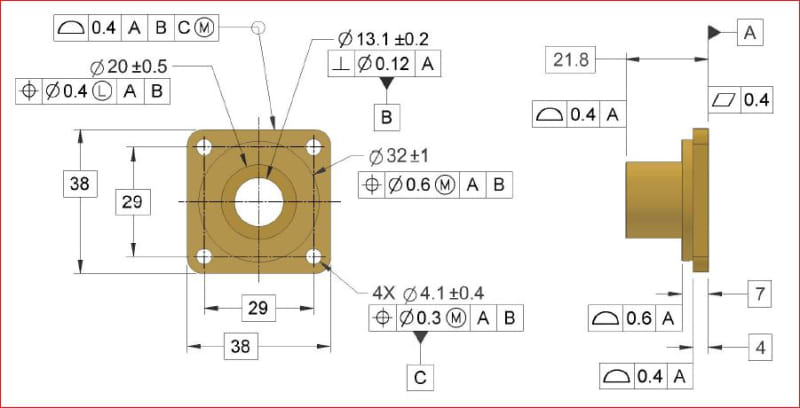Sem_D220,
I wasn't thinking about a scenario with rocking datum features. I'm not able to prepare a sketch at the moment, so I'll try to explain it with words (with a little help of a figure from the standard). Hopefully it will be clear enough.
For simplicity, instead of a pattern of four holes, let's imagine that there is just one hole. So let's consider dia. 9.2 +0.15/0 hole in fig. 4-19 in Y14.5-2009 and assume following:
- UAME of datum feature B has been produced at MMC, meaning that the feature is perfectly perpendicular to datum plane A;
- UAME of datum feature C has been produced at MMC, meaning that available position tolerance for that feature is dia. 0.1;
- axis of the UAME of datum feature C is perfectly perpendicular to A and at farthest possible distance relative to B = 57.45 (basic 57.4 plus half of 0.1).
- UAME of the dia. 9.2 +0.15/0 hole has been produced at MMC, meaning that available position tolerance for the hole is dia. 0.26;
- axis of the UAME of the 9.2 +0.15/0 hole is perfectly perpendicular to A and at closest possible distance relative to B = 16.87 (basic 8.7 plus basic 8.3 minus half of 0.26).
With these assumptions, the distance between the axis of the 9.2 +0.15/0 hole and the axis of datum feature C, when considered in |A|B|C>| frame of reference, is 40.58 (57.45-16.87).
Now, if the sequence of the datum features changes from |A|B|C>| to |A|C|B>|, the requirement for location of the true position of the 9.2 +0.15/0 hole also changes. The true position is now basically located from the center of the datum feature simulator C, and not from the center of the datum feature simulator B. This, in consequence, means that the possible range of distances between the center of the datum feature simulator C (axis of datum feature C) and the center of the considered hole at MMC is <40.4-0.13; 40.4+0.13> = <40.27;40.53>.
Since the actual distance between both axes, as given above, is 40.58, the hole must be rejected when checked against position wrt |A|C|B>|, even though the relationship between datum features B and C and their simulators didn't really change.

